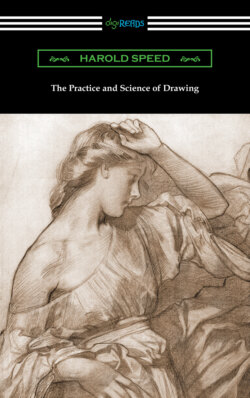Читать книгу The Practice and Science of Drawing - Harold Speed - Страница 21
На сайте Литреса книга снята с продажи.
ОглавлениеIn natural red chalk rubbed with finger; the high lights are picked out with rubber.
If you are asked to think of an object, say a cone, it will not, I think, be the visual aspect that will occur to most people. They will think of a circular base from which a continuous side slopes up to a point situated above its centre, as one would feel it. The fact that in almost every visual aspect the base line is that of an ellipse, not a circle, comes as a surprise to people unaccustomed to drawing.
But above these cruder instances, what a wealth of associations crowd in upon the mind, when a sight that moves one is observed. Put two men before a scene, one an ordinary person and the other a great poet, and ask them to describe what they see. Assuming them both to be possessed of a reasonable power honestly to express themselves, what a difference would there be in the value of their descriptions. Or take two painters both equally gifted in the power of expressing their visual perceptions, and put them before the scene to paint it. And assuming one to be a commonplace man and the other a great artist, what a difference will there be in their work. The commonplace painter will paint a commonplace picture, while the form and colour will be the means of stirring deep associations and feelings in the mind of the other, and will move him to paint the scene so that the same splendour of associations may be conveyed to the beholder.
But to return to our infant mind. While the development of the perception of things has been going on, the purely visual side of the question, the observation of the picture on the retina for what it is as form and colour, has been neglected—neglected to such an extent that when the child comes to attempt drawing, sight is not the sense he consults. The mental idea of the objective world that has grown up in his mind is now associated more directly with touch than with sight, with the felt shape rather than the visual appearance. So that if he is asked to draw a head, he thinks of it first as an object having a continuous boundary in space. This his mind instinctively conceives as a line. Then, hair he expresses by a row of little lines coming out from the boundary, all round the top. He thinks of eyes as two points or circles, or as points in circles, and the nose either as a triangle or an L-shaped line. If you feel the nose you will see the reason of this. Down the front you have the L line, and if you feel round it you will find the two sides meeting at the top and a base joining them, suggesting the triangle. The mouth similarly is an opening with a row of teeth, which are generally shown although so seldom seen, but always apparent if the mouth is felt (see diagram A). This is, I think, a fair type of the first drawing the ordinary child makes—and judging by some ancient scribbling of the same order I remember noticing scratched on a wall at Pompeii, and by savage drawing generally, it appears to be a fairly universal type. It is a very remarkable thing which, as far as I know, has not yet been pointed out, that in these first attempts at drawing the vision should not be consulted. A blind man would not draw differently, could he but see to draw. Were vision the first sense consulted, and were the simplest visual appearance sought after, one might expect something like diagram B, the shadows under eyes, nose, mouth, and chin, with the darker mass of the hair being the simplest thing the visual appearance can be reduced to. But despite this being quite as easy to do, it does not appeal to the ordinary child as the other type does, because it does not satisfy the sense of touch that forms so large a part of the idea of an object in the mind. All architectural elevations and geometrical projections generally appeal to this mental idea of form. They consist of views of a building or object that could never possibly be seen by anybody, assuming as they do that the eye of the spectator is exactly in front of every part of the building at the same time, a physical impossibility. And yet so removed from the actual visual appearance is our mental idea of objects that such drawings do convey a very accurate idea of a building or object. And of course they have great advantage as working drawings in that they can be scaled.
